Cognitive Psychology
Cognitive Psychology is very relevant to Technical Writing, Instructional Design, and Technical Illustration. Understanding how the eye and brain process written and graphic information before that information enters the conscious mind, for example, enables one to design information for ready assimilation by the end user. One can also minimize visual and mental fatigue, thereby extending the tolerable duration of concentrated attention. The place to start in developing that understanding is with the brain.
The Brain
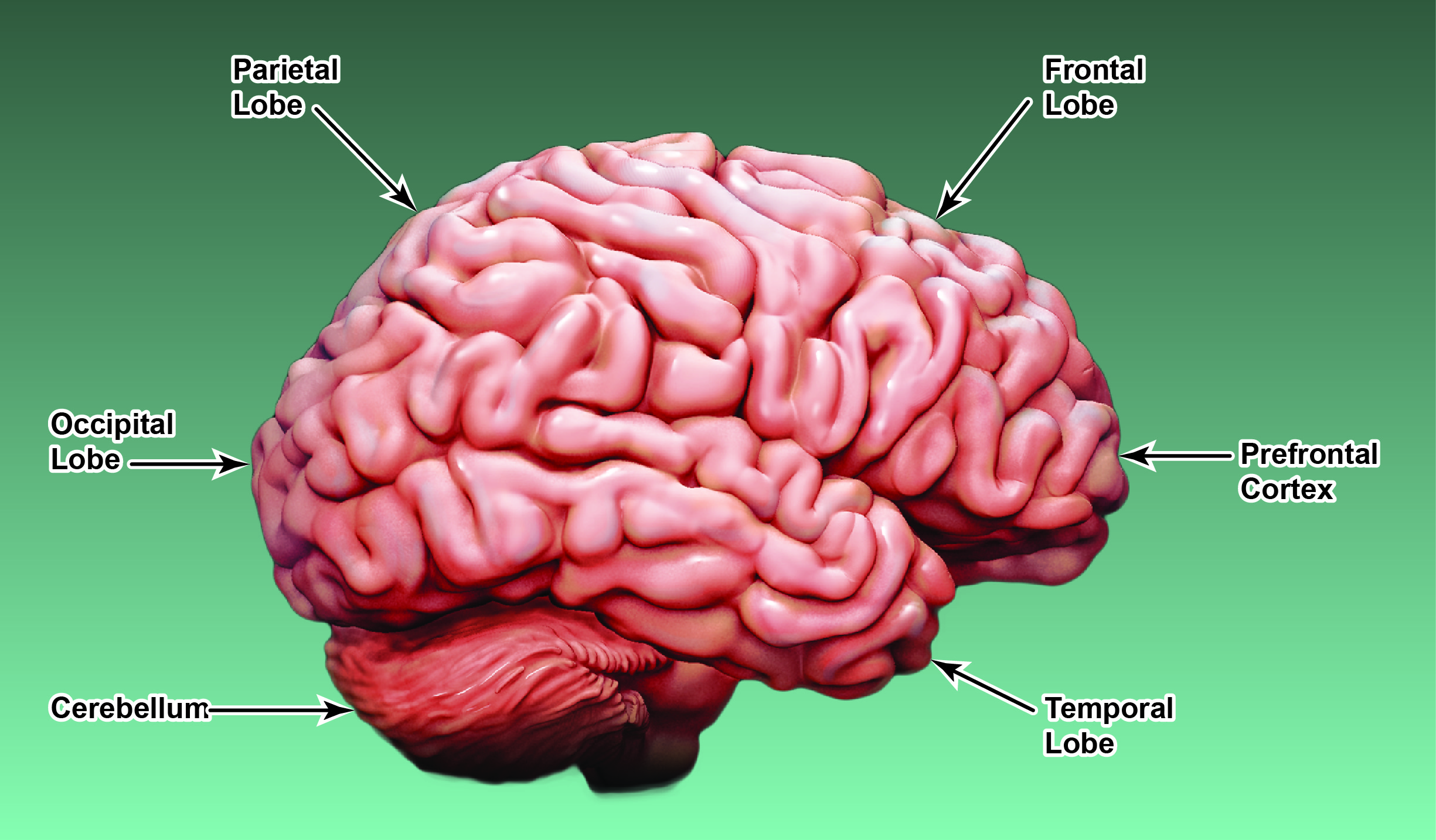
The brain is composed of two hemispheres, right and left, connected primarily by a thick band of white matter called the corpus callosum. The surface of the cerebral cortex is convoluted with ridge-like bulges called "gyri" (singular, "gyrus") and crease-like depressions called "sulci" (singular, "sulcus"). Each hemisphere comprises the following four main lobes:
- Occipital Lobe – The occipital lobes, the smallest of the cerebral lobes, are located at the posterior of the brain. The occipital lobe is considered the "hub" of visual perception because it processes visual data transmitted to it from the retinas of the eyes.
- Parietal Lobe – The parietal lobes are located anterior to and above the occipital lobes, posterior to the central sulcus, which separates the parietal and frontal lobes. The parietal lobes process spatial location, proprioception, pressure, vibration, pain, and sensory integration.
- Frontal Lobe – The frontal lobes are located immediately anterior to the central sulcus. The frontal lobes manage higher cognitive functions and voluntary movement. The anterior region of the frontal lobes is called the prefrontal cortex, which orchestrates thoughts and actions: working memory, motivation, problem-solving, planning, decision making, and personality expression. Broca's area, which is responsible for speech production, is located in the posterior inferior frontal gyrus and pars triangularis of the dominant hemisphere, normally on the left side.
- Temporal Lobe – The temporal lobes are located anterior to the occipital lobes and below the parietal lobes. The temporal lobes process auditory information and provide visual recognition of objects and faces. The hippocampus, an infolding of the medial temporal cortex, is involved in the encoding, consolidation, and retrieval of memories. The amygdala, which is involved in the processing of certain emotions, is also located in the temporal lobe. Wernicke's area, which is involved in language comprehension, is located on the superior gyrus of the left temporal lobe at the juncture with the parietal lobe.
Memory
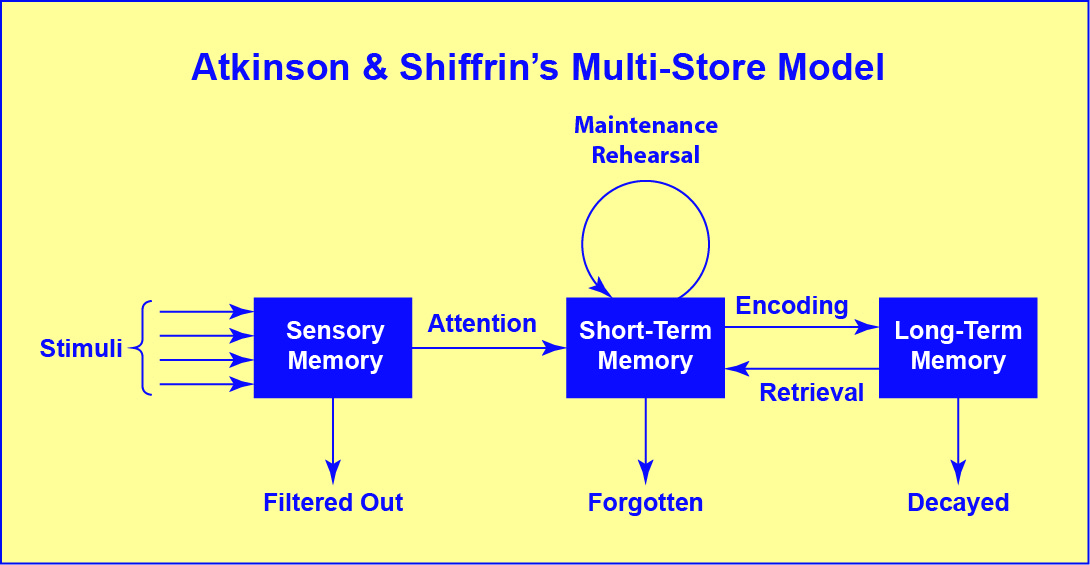
Early in memory research, cognitive psychologists were concerned primarily with the duration for which information could be stored in each of the cognitive components they had identified. Hence they convened upon the term “memory.” to refer to them. Atkinson and Shiffrin identified three major components, or "stores," of memory:
- Sensory Memory – Sensory memory comprises five principal modalities: vision (seeing), audition (hearing), olfaction (smelling), gustation (tasting), and tactile sensation (touching). Sensory data are retained in sensory memory for only a brief fraction of a second. Sensory data are processed and filtered before they are presented to short-term memory, in accordance with the attention consciously directed toward them. Certain sensory data, such as a sudden noise or a sharp pain, can capture an individual's attention without conscious direction, however.
- Short-Term Memory – In common parlance, the term “memory” connotes the recall of information that had been stored at a previous time. Accordingly, most people associate the term “short-term memory” with the recall of Information stored recently, perhaps within the last week or so. In the field of psychology, however, the term “short-term memory” is somewhat of a misnomer, because it refers specifically to what might be better termed the “presently conscious mind.” Normally, information can be stored in short-term memory (currently termed "working memory") for a relatively short time, up to about 30 seconds – unless it is refreshed or “rehearsed” to maintain it for a longer duration.
For all human beings, working-memory capacity is actually quite limited in the number of items it can process at any one time. In the mid-1950s, psychologist George Miller estimated this limit to be about seven items – the proverbial “magical number seven, plus or minus two.” More recent researchers have shown, however, that the actual limit is only about three or four items. This is true even for brain surgeons, rocket scientists, and robotics engineers at the cutting edge. By the same token, the complexity of an individual item, or “schema,” can vary.
- Long-Term Memory –
A virtually unlimited quantity of information can be retained in long-term memory virtually indefinitely, although it can decay over time. In order for an individual to think again about information stored in long-term memory, it is necessary to retrieve it from long-term memory into working memory. Information is initially encoded as schemata (units of neural associations among related data elements) from working memory into long-term memory for storage. When a schema is later retrieved into working memory, it is decoded for further processing. At that time, the schema becomes labile, or subject to further consolidation by revision or addition of new data. It is subsequently re-encoded back into long-term memory in the revised form for further storage. Lability and re-consolidation help to explain why recollections of previous events are not always accurate.
Baddeley's Model of Working Memory
Dr. Baddeley determined that working memory is not a unitary cognitive component, as had previously been assumed, but comprises the following constituent components, each of which possesses dedicated working-memory capacity and each of which has a direct connection to long-term memory:
- Central Executive – A flexible supervisory system that regulates selective attention, coordinates the other components within working memory, binds information from multiple sources into coherent episodes, shifts between tasks and retrieval strategies, inhibits or suppresses dominant or automatic responses, and makes working memory and long-term memory work together.
- Visuospatial Sketchpad – The store that holds visual information for manipulation. The visuospatial sketchpad can work simultaneously with the phonological loop to process both auditory and visual stimuli without either of the processes affecting the efficacy of the other.
- Episodic Buffer – A limited-capacity passive system dedicated to linking information across domains to form integrated units of visual, spatial, and verbal information with time sequencing, such as the memory of a story or movie scene.
- Phonological Loop – Deals with sound or phonological information. It consists of two parts: a short-term phonological store with auditory memory traces that are subject to rapid decay and an articulatory rehearsal component that can revive the memory traces. Visually presented language can be transformed into phonological code by silent articulation and thereby be encoded into the phonological store.
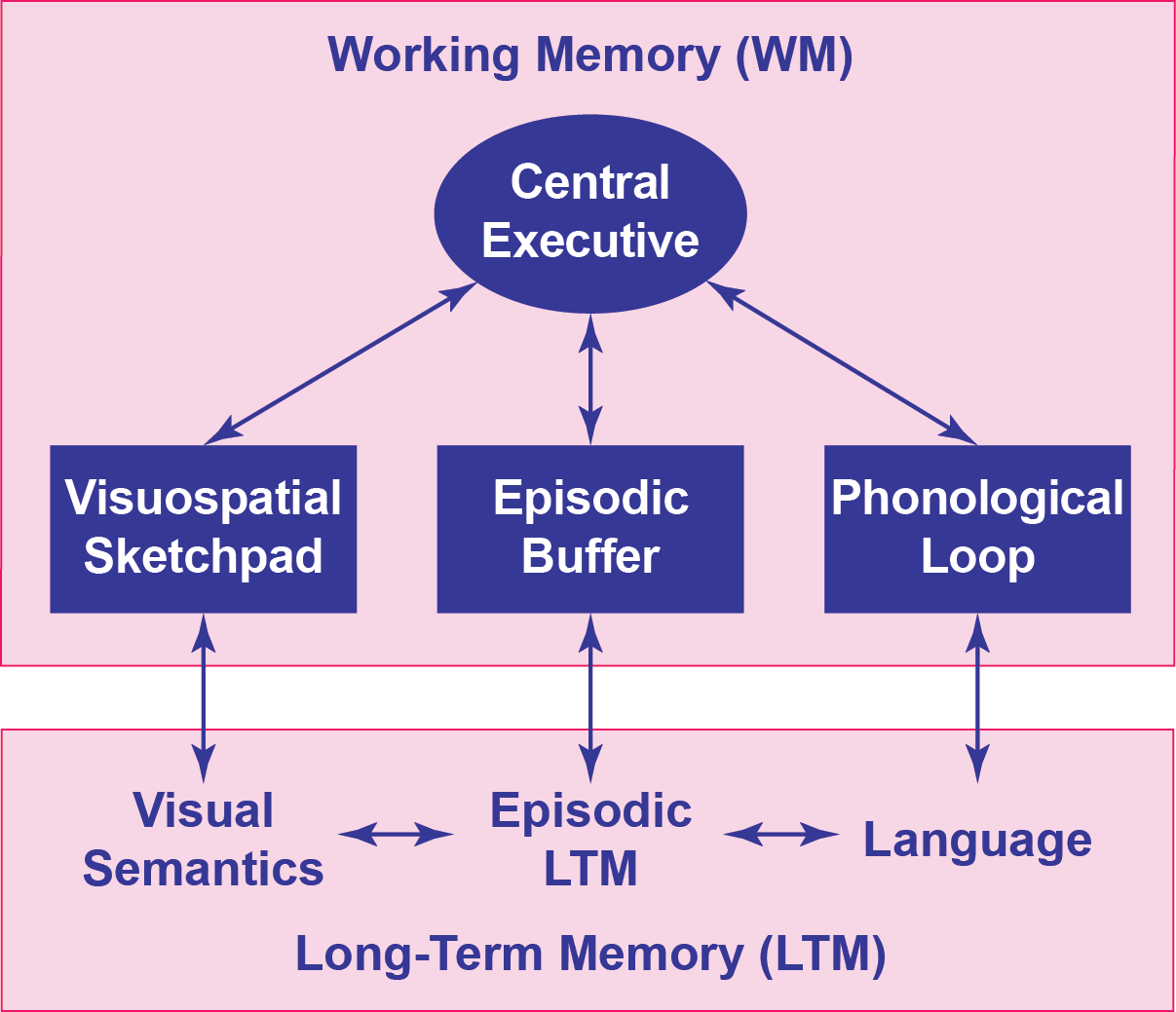
Cognitive Load Theory
"Is this glass half-empty . . . ?"
For any individual, the capacity of working memory (i. e., the presently conscious mind) is very limited. According to Cognitive Load Theory, as proposed by Dr. Sweller, cognitive load is the burden imposed on working memory due to the effort needed to concentrate on something. That burden may be attributed to any of the following three factors:
- The first factor is the inherent complexity of the subject matter on which a learner's attention is focused; this factor is called "intrinsic cognitive load." In order to grasp certain subject matter at all, the associated intrinsic cognitive load is unavoidable, and some subject matters are inherently more difficult to grasp than others (consider atomic physics, for example).
- The second factor has to do with the manner in which the instructor or instructional materials present the subject matter; this factor is called "germane cognitive load." For example, an instructor who uses very confusing language or, say, an arcane analogy, is imposing heavy germane cognitive load, while a simple illustration that makes the idea very clear is imposing light germane cognitive load. Although a certain degree of germane cognitive load is unavoidable, the technical writer or instructional designer has considerable control over the level of germane cognitive load that he or she is imposing.
- The third factor is called "extraneous cognitive load," and it has nothing to do either with the inherent difficulty of the subject matter or with the manner of presentation. It includes essentially everything else that may impinge on an end user's or learner's working memory. Examples might include the lighting level or temperature in the classroom, an uncomfortable desk chair, hunger, or distractions. Many sources of extraneous cognitive load may be eliminated or controlled; the objective is to minimize them in order to facilitate learning.
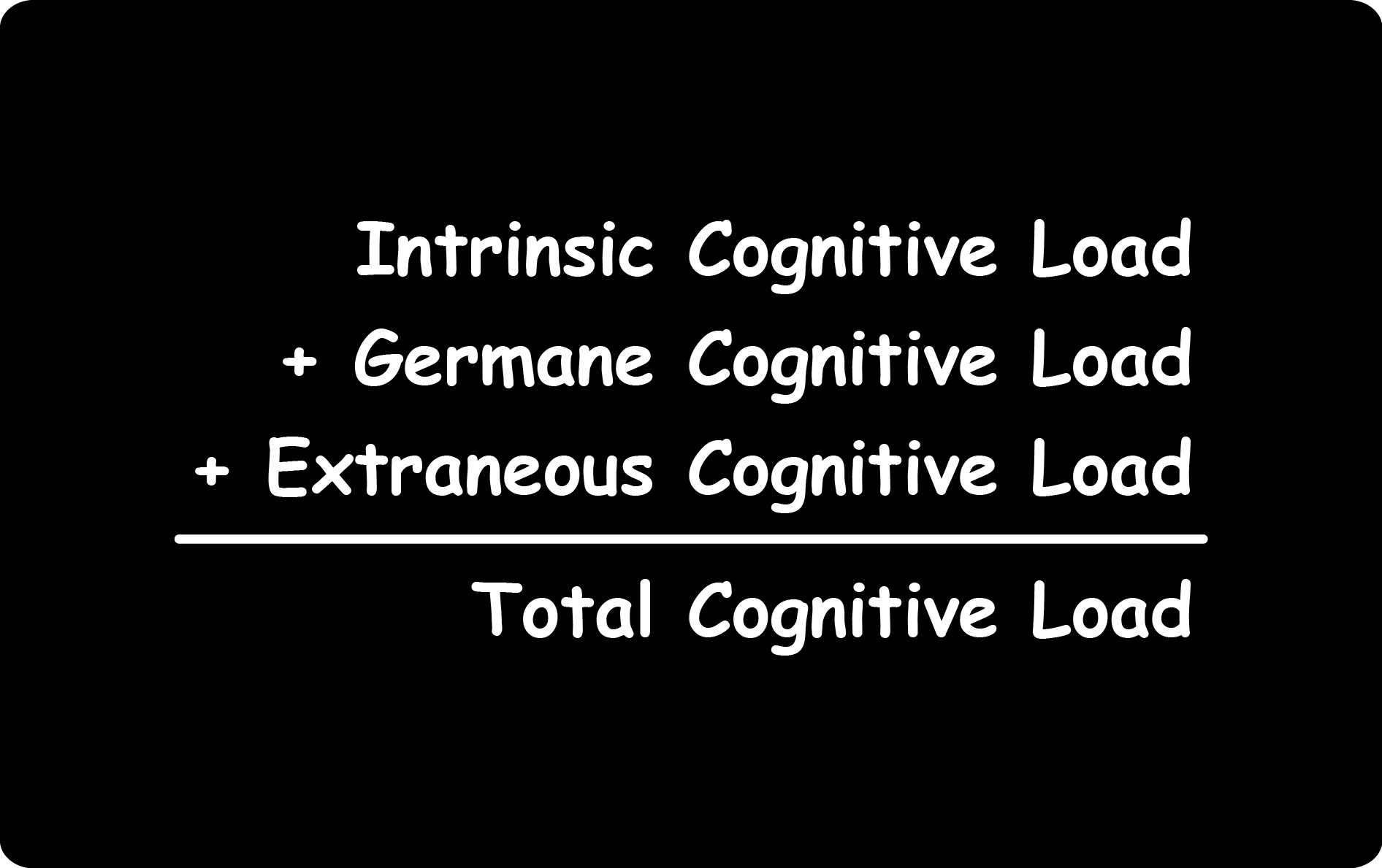
Intrinsic cognitive load plus germane cognitive load plus extraneous cognitive load equals total cognitive load. If total cognitive load exceeds working-memory capacity, the learner will be overwhelmed, and learning may not occur at all. Against the limited capacity of working memory, the complexity of technical information with which each of us must deal obviously increases constantly. For this reason, I take a cognitive-psychological approach to developing technical and instructional materials. I take pains to minimize extraneous cognitive load and optimize germane cognitive load, thereby maximizing the allocation of working-memory capacity for the ineliminable intrinsic cognitive load that is endemic to any intellectual endeavor.
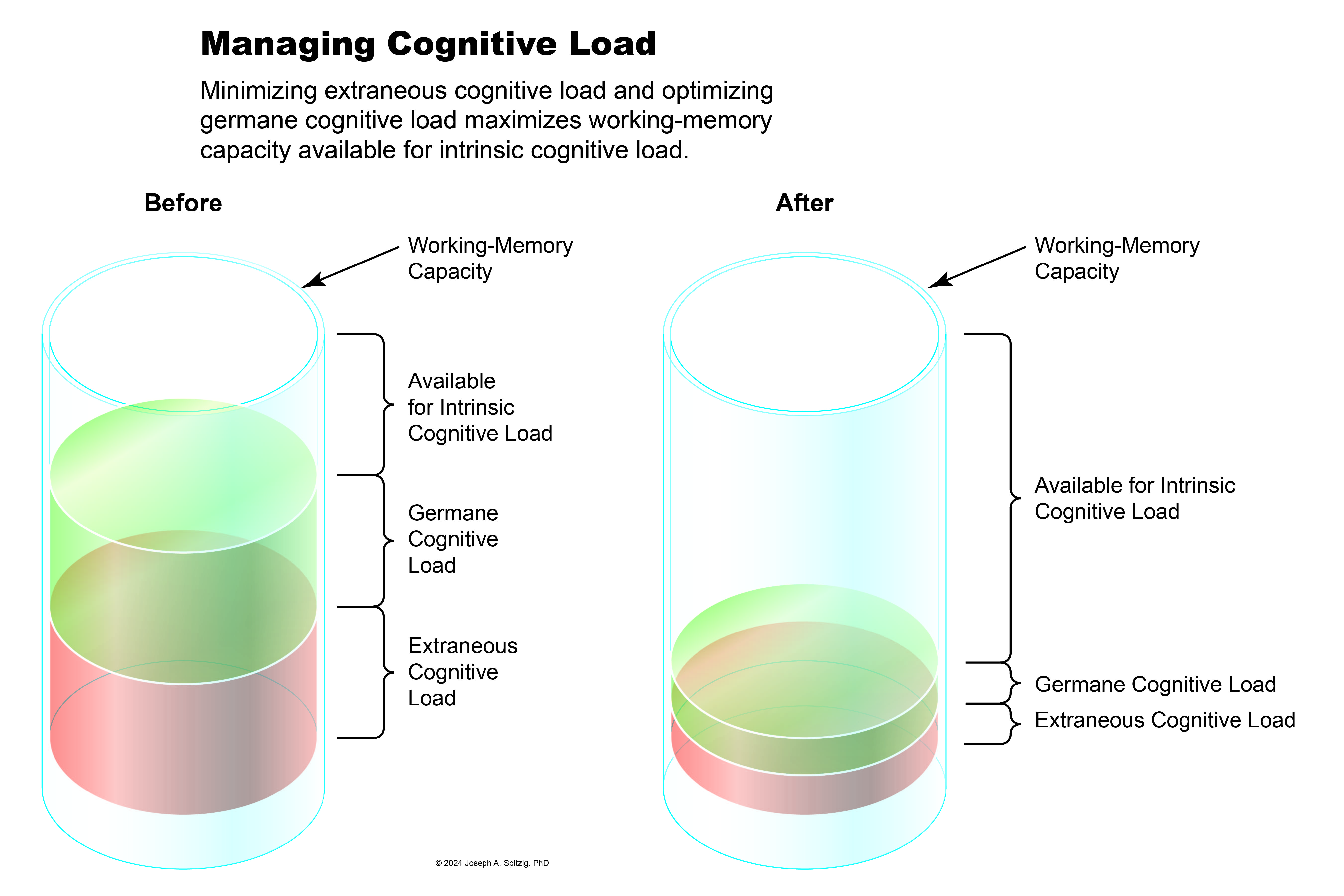
Modalities
The prevailing cognitive theories address primarily visual and auditory modalities for sensory-data acquisition but neglect olfactory, gustatory, and tactile modalities. For chemists, zymurgists, and culinary artists, these other sensory modalities are obviously essential. End users who are visually or auditorially impaired also require accommodation. For these alternate modalities, parallel processes analyze and filter sensory data prior to entering working memory, similarly to those for visual and auditory modalities. Although I have some familiarity with Section 508 of the Americans with Disabilities Act, the vast majority of end users in the industries that I serve are capable of understanding written or illustrated information.



 Early in memory research, cognitive psychologists were concerned primarily with the duration for which information could be stored in each of the cognitive components they had identified. Hence they convened upon the term “memory.” to refer to them. Atkinson and Shiffrin identified three major components, or "stores," of memory:
Early in memory research, cognitive psychologists were concerned primarily with the duration for which information could be stored in each of the cognitive components they had identified. Hence they convened upon the term “memory.” to refer to them. Atkinson and Shiffrin identified three major components, or "stores," of memory:

 Intrinsic cognitive load plus germane cognitive load plus extraneous cognitive load equals total cognitive load. If total cognitive load exceeds working-memory capacity, the learner will be overwhelmed, and learning may not occur at all. Against the limited capacity of working memory, the complexity of technical information with which each of us must deal obviously increases constantly. For this reason, I take a cognitive-psychological approach to developing technical and instructional materials. I take pains to minimize extraneous cognitive load and optimize germane cognitive load, thereby maximizing the allocation of working-memory capacity for the ineliminable intrinsic cognitive load that is endemic to any intellectual endeavor.
Intrinsic cognitive load plus germane cognitive load plus extraneous cognitive load equals total cognitive load. If total cognitive load exceeds working-memory capacity, the learner will be overwhelmed, and learning may not occur at all. Against the limited capacity of working memory, the complexity of technical information with which each of us must deal obviously increases constantly. For this reason, I take a cognitive-psychological approach to developing technical and instructional materials. I take pains to minimize extraneous cognitive load and optimize germane cognitive load, thereby maximizing the allocation of working-memory capacity for the ineliminable intrinsic cognitive load that is endemic to any intellectual endeavor.